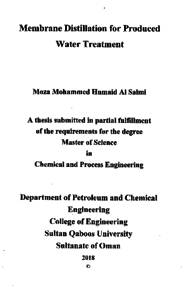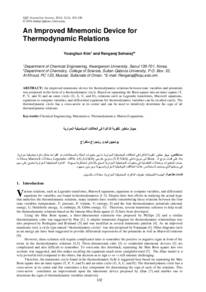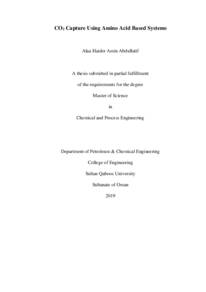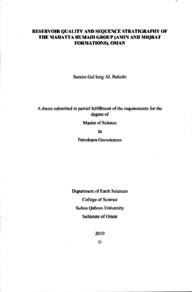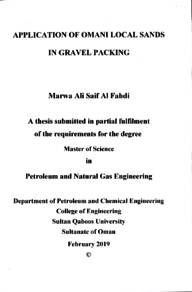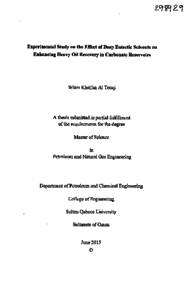Document
Membrane distillation for produced water treatment
Publisher
Sultan Qaboos University
Gregorian
2018
Language
English
English abstract
Large amount of produced water is generated as a waste stream during oil and gas extraction operations. Discharging produced water to the environment is a general practice, which can pollute surface and underground water. Treatment of this water will not only make a harmless product but it also provides a valuable product to consume in different beneficial uses. Various methods are used to treat produced water but they are limited by high treatment cost, high energy requirement, use of hazardous chemicals, large environmental footprints and discharge of secondary waste. Due to its attractive features, Membrane distillation (MD) has been proposed to treat produced water. In this study, the feasibility of direct contact membrane distillation (DCMD) technology for produced water treatment was investigated, Several techniques were employed to characterize the feed and effluent water including total dissolve solids (TDS), total organic carbon (TOC) and gas chromatography-mass spectroscopy (GC-MS). The membranes were investigated before and after experiments using Scanning Electron Microscope (SEM) coupled with Energy Dispersive X-ray spectroscopy analysis (EDS), Fourier Transform Infrared (FTIR) and Contact angle (CA) measurements. High rejection in term of total dissolved solids and total organic carbon were obtained. More than 99.9% of dissolved solids were retained and up to 93.3% of TOC were rejected. The possible reason of the carbon passage was the presence of volatile organics in the water. The permeate flux increased with feed temperature, which was expected since the driving force of this process is mainly controlled by the temperature difference between feed and permeate sides. It was also found that pre-treatment of produced water using 0.45 um filter did not have much effect on the performance of the MD. High stability of the polypropylene membranes was observed during the long-term test. A slight gradual reduction of the permeate flux was observed due to fouling. Washing the membrane with de-ionized water was found to be an effective method for cleaning the membrane and restoring the permeate flux indicating the absence of irreversible fouling.
Member of
Resource URL
Arabic abstract
كمية كبيرة من الماء تنتج حقول النفط خلال عمليات استخراج النفط والغاز. هذه المياه تحتوي على الكثير من الشوائب والتي يكون البعض منها سامة ولها تاثير مباشر على البيئة. لذلك قامت الكثير من الدول بسن القوانين في كيفية معالجة وطرق التخلص من هذه المياه الكثير من التقنيات الفيزيائية الكيميائية والأحيائية تم اختبارها لمعالجة هذه المياه إلا أن أغلب هذه التقنيات غير فعالة تقنيا واقتصاديا. ومن أهم سلبيات هذه التقنيات حاجتها لمساحات كبيرة للتنفيذ، مكلفة وتتضمن استخدامها بعض المواد الكيميائية الضارة. تم اقتراح تقنية الى (Membrane distillation) لمعالجة هذا النوع من المياه لما تتمتع به من ميزات كثيرة كالقدرة على معالجة المياه شديدة الملوحة، يتطلب تشغيلها حرارة وضغط أقل من العمليات الأخرى وفعاليتها في منع مرور الجزيئات الغير متطايرة تصل إلى ۱۰۰% تهدف هذه الرسالة لدراسة فعالية تقنية ال Membrane distillation في معالجة المياه المصاحبة لإنتاج النفط. في هذه الدراسة تم استخدام عدة أنواع من المياه وهي: الماء النقي الخالي من الأملاح، الماء المالح المحضر مخبريا والماء المنتج من حقول النفط لدراسة تأثير مكونات المياه على فعالية طريقة المعالجة. تم تغيير درجة حرارة الماء المعالج بين 40 إلى 80 درجة مئوية بينما تم تثبيت درجة حرارة الماء في الجانب الآخر من الغشاء على ۲۳ درجة مئوية. تم تحليل الماء الناتج من هذه العملية باستخدام طرق مختلفة لمعرفة مكونات الماء. وتم تحليل الغشاء (Membrane) قبل وبعد التجارب لمعرفة تأثر خصائصه ولمعرفة خصائص الطبقة المتكونة على سطحه بعد عملية المعالجة نتائج هذه الدراسة أثبتت فعالية التقنية المستخدمة في معالجة هذه المياه المنتجة من حقول النفط، إذ بلغت نسبة الأملاح التي منعت من المرور خلال الغشاء أكثر من ۹۹ , ۹ % وأكثر من ۹۳٫۳ % بالنسبة للمواد العضوية. السبب وراء مرور بعض من المواد العضوية هو وجود مواد عضوية متطايرة في عينة الماء والذي لا يمكن تفاديه باستخدام هذه التقنية كذلك أوضحت أن الأغشية المستخدمة لم تفقد خصائصها الرئيسية بعد تعرضها لأنواع مختلفة من المياه وإمكانية استعادة فعاليتها الأولية باتباع عملية تنظيف مناسبة باستخدام الماء النقي.
Category
Theses and Dissertations

